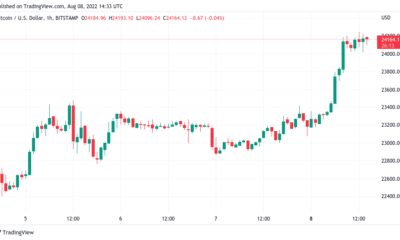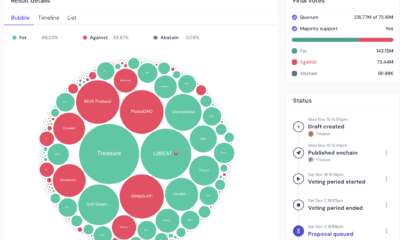Sales & Marketing
‘Bullish’ marketing industry plans to boost spending power in 2024

UK marketing leaders are gearing up for a ‘bullish’ 2024, with more than 70% planning to boost digital budgets this year, new data shows.
Following four years of economic flatlining and commercial pressures for many of the UK’s top marketers, 2024 is expected to see a resurgence in industry optimism, with increased investment being directed in key growth areas including AI, websites, SEO, broadcast and podcasts, as well as email and content marketing.
The data from more than 500 UK marketing leaders, commissioned by search-driven content agency No Brainer, is available to in-house and agency marketers now. The first report is called the 2024 eCommerce Trends Report.
In addition to No Brainer’s findings, a recent Statista report indicates the eCommerce market is set to reach a projected £100b ($124b) in the UK for the first time in 2024, and eComm marketers are poised to make 2024 the year they seize a greater share of consumer spending.
The report by No Brainer also reveals significant spending growth in key areas of marketing, with many marketing decision markers saying they intend to invest over 60% more than they did in 2023 in the following areas:
- AI: 64% to increase spend by as much as 60%
- Website: 64% to increase spend by as much as 60%
- SEO: 62% to increase spend by as much as 60%
- TV, Radio & Podcasts: 59% to increase spend by as much as 60%
- Email Marketing: 58% to increase spend by as much as 60%
- Content Marketing: 57% to increase spend by as much as 60%
- Digital PR: 57% to increase spend by as much as 60%
- Influencer Marketing: 56% to increase spend by as much as 60%
- Organic social: 56% to increase spend by as much as 60%
- Paid search: 55% to increase spend by as much as 60%
Some of the highest budget increases came from marketers working in sectors including Education with 69% increasing by up to 60%, Finance with 64% increasing by up to 60%, and Retail with 56% increasing by over 40%. Only 14% of marketing decision makers said they’ll be dialling back on budgets in 2024.
Gary Jenkins, Director at No Brainer, said: “Four years of rising costs, inflationary pressures, and squeezed budgets has made life tough for UK marketing leaders tasked with delivering growth, but we’re expecting to see that turn around in 2024 with many taking a more bullish approach in terms of spending power.
“This is great to see, and not just because we play in this space, but because if businesses of all sizes are serious about recovery and growth, then investing strategically in the right areas of marketing is crucial. Sadly, in challenging times, these are the things that can often be the first cut.
“When every penny matters, like it has in recent years, then there’s a laser focus on marketing leaders proving the value of every pound they spend, and quite rightly. It’s got everyone challenging the ROI of their spending across every marketing sector, and the same rule should apply with these increased budgets.
“It’s about putting them to best use. A solid, strategically planned marketing strategy can unlock new audiences, drive more revenue from existing ones, and drive more brand loyalty and advocacy, so it’s still a case of spending smart, even if spending more.”
Interested in hearing leading global brands discuss subjects like this in person? Find out more about Digital Marketing World Forum (#DMWF) Europe, London, North America, and Singapore.
Sales & Marketing
Why social listening platforms can’t listen – and how SocialVoice is looking to step in

The market opportunity for brands who get influencer marketing right is huge.
According to Goldman Sachs, the creator economy is worth around $250 billion (£205.4bn) today. By 2027, it could hit $480bn (£394.5bn), in line with predicted growth for global digital advertising spend. In line with this trend is an increasing preference for brands to use nano- and micro-influencers in their campaigns. The State of Influencer Marketing 2023 Report puts this at 39% and 30% respectively. With the rise of trends such as FinTok and others front and centre, no longer is there a subject which cannot be touched by an influencer; someone passionate, authentic and knowledgeable enough to earn consumer trust.
Getting the right influencers, in terms of what they say, how they say it and how many people they say it to, is therefore vital. Indeed, an entire martech sector has mushroomed in the form of social listening. Yet Nicholas Greig, chief revenue officer at SocialVoice, has a problem with the term.
“Social listening platforms can’t listen,” explains Greig. “All they can do is scan the metadata.”
While social listening tools can look at hashtags and comments, crunch engagement rates, and look at the sentiment of the written word, SocialVoice believes there is no tool currently on the market which can get ‘inside’ a video and analyse the voice. Until now.
The aim of SocialVoice is to enable analysis of an influencer’s past activity, through every frame of every video on every platform. Tone of voice can be analysed, beyond the written word, to assuage fears around brand safety as well as brand fit. This can go from the usual sentiment analysis to understanding personal versus corporate tone, to extrovert versus introvert, to liberal versus conservative. “Because we’re moving to nano- and micro-influencers, we’re not bringing them in for shoots anymore, so we’re relying on the quality of their recording,” explains Greig.
From a technology standpoint, it will not be a surprise that AI is at the heart of the solution, with three primary facets; deep analysis using machine learning tools, statistical approaches to identify pattern correlation across time-based events, and processing at speed. Almost two thirds of those polled in the State of Influencer Marketing report (63%) plan to use AI in executing their influencer campaigns, with two thirds of those brands using it for influencer identification.
What this looks like in terms of product is the Influencer Integrity Report, the first go-to-market effort from SocialVoice. The analysis of time-based events and processing at speed is combined so brand managers can input the influencer link and then get a report soon afterwards backed up by industry standards – toxic and profane content is based on GARM (Global Alliance for Responsible Media) metrics – and headlined by an overall trust score (left).
In the example MarketingTech saw, regarding a well-known influencer in the skincare industry, a specific brand appeared 273 times based on hashtag and written word analysis. For video scripts, the brand appeared 3648 times (right). Tone of voice noted variance between neutral and joyful.
Greig believes this will solve a fundamental industry problem. “We realised that there were some very big problems in the world of influencer marketing that, despite its growth, were affecting uptake from industry sectors such as banking, or from industry sectors where compliance and conservatism was more prevalent,” says Greig.
“These problems come around the fact that not a single influencer discovery platform in the world can be trusted to do proper vetting, or background checking, of the influencer,” adds Greig. “Checking influencers takes hours, and they can’t go back and check everything that an influencer has ever said – so they cut corners, they look at a random sample of videos, and then they go into a campaign [with a] lack of trust in whether the influencer has any hidden surprises in their background.”
While it remains early days, Greig notes that the trust score is the key element for customers on board thus far. The company has trademarked the term ‘trust my voice’ in anticipation not just of this, but for future cases beyond the brand and agency side. “One of the ways where we see this going forward is that influencers themselves on their profile will have a ‘trust my voice’ link,” offers Greig. “They’ll have that from a software as a service perspective.”
SocialVoice is exhibiting at the upcoming DMWF Europe event, on 21-22 November in Amsterdam, with something a little more enticing than usual. Those who visit the stand will have the ability to have one free check of an influencer of their choice – so the company has a strong bet on their value proposition.
“I think it will shock people as to just how limited the information is they have to make right decisions, and just how open they are to problems,” says Greig.
“We are still very much in a concept [phase],” he adds. “It’s going to be very difficult for anyone to compete against us. It’s not just the AI ability, it’s the scale of what it is that we’re doing; it’s the ability to do it at speed and do thousands of influencers at the same time.”
Insert picture credit: SocialVoice
Photo by Daniel Gaffey on Unsplash
Interested in hearing leading global brands discuss subjects like this in person? Find out more about Digital Marketing World Forum (#DMWF) Europe, London, North America, and Singapore.
Sales & Marketing
Clevertouch creates European consultancy and empowers marketers with AI marketing automation
Clevertouch Marketing, a marketing technology consulting and service provider, has formed a new strategic team to drive customer conversion from martech across its European client base.
This, in conjunction with new AI product development in its proprietary Momentum software, will bring productivity in martech to the forefront, at a time when marketers need it most acutely.
As Clevertouch Marketing changes its overall name to Clevertouch Consulting, the company has created a senior team focused on client revenue generation, customer insights and conversion metrics. The team is also investing in the development of new powerful AI marketing tools.
The development of ContentAI, a feature within Clevertouch Consulting’s Momentum software, ensures artificial intelligence is driving maximum productivity within Clevertouch customer marketing teams. It allows the rewrite of email and landing page content, greatly improving the capabilities of marketers and reducing the time it takes to launch assets. ContentAI is backed by a unique persona toolset that allows marketers to ensure generated content fits the tone and personality of the teams and the business. Momentum is used by leading brands such as Fujitsu, Atos and British Land.
To support this, Clevertouch Consulting has strengthened its leadership with a mix of promotions and hires. Elaine Webley has been appointed as COO and CMO to lead operations and marketing strategy, having previously served as Managing Director and Client Services Director. Stuart West, previously Vice President International of BrightTALK, will hold the Chief Revenue Officer position and lead the team across its services and SaaS products. Jamie Burrell, responsible for the company’s consulting services, will take the position of Chief Strategy Officer, and CEO and founder, Adam Sharp, will provide ongoing leadership and market insights. Lucy Larner also joins Clevertouch as Chief Financial Officer after fifteen years in various SMB finance roles.
Adam Sharp, CEO at Clevertouch Consulting, said: “Economic times are tough, and as marketers we all have to sharpen our focus on revenue delivery, customer conversion and productivity within our day-to-day activities. We are committed to investing in the most advanced marketing products and services, driving the efficiencies created by AI, but also backed by a super strategic team to give clients the best possible business outcomes.
“Our name change reflects the changing nature of the business and the desire for clients to bring the martech capability in house, with the support of Clevertouch Consulting to optimise their investment.”
Interested in hearing leading global brands discuss subjects like this in person? Find out more about Digital Marketing World Forum (#DMWF) Europe, London, North America, and Singapore.
Sales & Marketing
Consumers are 5X more likely to view advertising within non-premium content as low quality
Music video network Vevo, and UK broadcaster Channel 4 have released the findings of a joint study, ‘Retaining Trust and Quality in a Sea of Content’.
The survey of 1,000 British consumers (ages 16 to 40 years old who regularly watch video content) identified and quantified the factors that boost the value of ads consumed within ‘fit for TV’ content on YouTube.
Advertisers benefit from being adjacent to premium content in three key ways, according to the study.
Viewers are more likely to watch premium content in superior environments – and as a result are open-minded to seeing ads as part of that experience.
Premium content is 3.2x more likely to be viewed on a TV than non-premium content, meaning:
- It is more likely to be watched socially, organically boosting reach
- Viewers enjoy longer, dedicated sessions, enhancing engagement
- The content is enjoyed in a more relaxed, immersive setting, increasing reception
With the bigger screen experience, respondents were more open to and expected ads, as they are seen as standard in this environment.
Audiences are more likely to have a positive emotional response to watching premium publisher content – creating a positive halo effect on advertising brands.
The study found an almost 50% uptick in people who either liked or loved fit for TV content vs. non-premium content, translating into significant benefits for ad exposure within these environments, such as higher levels of attention paid to the ad (more than 2x that of non-premium). Those that enjoyed the content they consumed were also twice as likely to consider the brand in the future.
The ad itself was also considered more enjoyable and shareable in ‘fit for TV’ content, with 62% of respondents having said they enjoyed the ad they saw when they liked or loved the surrounding content (vs. 28% who watched the same ad in content that they did not enjoy). Additionally, these premium content viewers saw noted improvements in their impression of the ad brand, with 61% having recalled seeing their favourite ad being within premium content.
Brands advertising with premium publishers are assumed to have increased value, credibility, and trustworthiness.
In most cases, trust and believability metrics were doubled when an ad was found within premium content. Conversely, negative connotations for that brand decreased five-fold.
Similarly, quality and desirability of brands saw a significant upswing from being within premium environments. In fact, the study reported nearly 3x more positive perception through placement within premium content, while ads in non-premium were 5x more likely to be perceived as low quality.
Overall, the expectations of advertising brands are fundamentally elevated when situated within fit for TV content, with the association that ads and the content they sit with have a similar quality.
James Cornish, senior VP, International Sales & Partnerships, Vevo, said: “Vevo partnered with Channel 4 on this research to help unlock insights that can help advertisers navigate an increasingly complicated and ever-growing video landscape. Both Vevo and Channel 4 are committed to professional production standards and consistent high quality that cuts through. For advertisers, not all content is the same and nor are publishers. As this research shows, premium publishers’ content delivers significant advantages: a safe and positive environment that fosters trust, prestige, and receptivity.”
David Amodio, deputy head of digital innovation and 4Studio, Channel 4, said: “Since the launch of 4Studio, our social content production and distribution arm, we’ve built a significant presence across a number of the tech platforms. We’ve achieved this by distributing both established TV content and original content through new channels such as 4.0. It’s been a learning curve understanding how to cut through and find new audiences, but we wanted to team up with a global established expert like Vevo, who shared our production values and standards. Our objective was to gain a better understanding of the benefits on offer to advertisers through accessing TV content within these new environments vs all the other video content available.”
Methodology
Flood + Partners surveyed 1,000 U.K. consumers, ages 16-40 years old, who regularly watch video content in June 2023, through their highly engaging and dynamic platform ‘Honesty Box’. Respondents were offered to choose which content they wanted to watch from a selection of videos within their groups, to make it more representative of natural viewing outside of a survey setting. Questions were gamified, capturing instinctive responses and high engagement.
400 of these respondents were recontacted for a follow-up survey to understand how their response to the material they saw might have evolved over time. For the qualitative portion of the research, 16 consumers also participated in a “deep dive”, which included a five-day daily diary, daily vlog, and final one-on-one Zoom interview.
BARB’s latest ‘Fit for TV’ framework served as the benchmark to define which content is premium vs non-premium. Content from Channel 4 and Vevo was tested as premium content vs. selections of content that doesn’t meet ‘Fit for TV framework’.
Interested in hearing leading global brands discuss subjects like this in person? Find out more about Digital Marketing World Forum (#DMWF) Europe, London, North America, and Singapore.
-

 Technology & Innovation2 years ago
Technology & Innovation2 years agoHow to get people to help you
-

 Technology & Innovation2 years ago
Technology & Innovation2 years agoWhy are scams getting worse?
-

 Sales & Marketing2 years ago
Sales & Marketing2 years agoVodafone invites Snapchatters to connect with Emma Raducanu virtually
-

 Cryptocurrency2 years ago
Cryptocurrency2 years agoBitcoin price targets 8-week highs as Ethereum reaches $1.8K
-

 Cryptocurrency1 year ago
Cryptocurrency1 year agoAre there too many cryptocurrencies?
-

 Technology & Innovation2 years ago
Technology & Innovation2 years agoHow Log4Shell threatens the Internet
-

 Business & Finance2 years ago
Business & Finance2 years agoHere’s How Apple CEO Earned 500% More In 2021
-

 Business & Finance2 years ago
Business & Finance2 years agoUN Announces Talks To Help Resolve Sudan’s Political Crisis















